Mitriostigma axillare
Mitriostigma axillare Hochst.
Family: Rubiaceae
Common names: dwarf-loquat (Eng.); dwerglukwart (Afr.) South African National Tree List no. 689.2
SA Tree No: 689.2
Introduction
With its green glossy leaves, white star-shaped flowers, bright orange fruits and sweetly fragrant aroma, this eye-catching small tree is undoubtedly a gardener's fantasy come true.
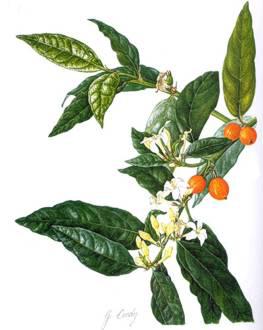
Description
Description
Evergreen shrub 0.5-4 m tall; bark brown, smooth, adhering. Buds hairless. Twigs hairless, stout, dull, brown or green. Leaf scars opposite, meeting as a line. Stems square, thornless.
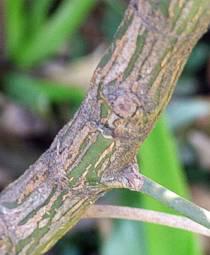
Leaves opposite, simple; petioles 5-10 mm long, glabrous or nearly so; bases not unusually enlarged; buds well exposed; leaf blade 60-100(-200) mm long, 20-30(-60) mm wide, lanceolate to elliptical, apex acute, base obtuse to truncate, surface glossy above, dull, hairless below, veins hairless or nearly so, margin not toothed. Inflorescence an axillary, erect head, flower-stalks hairless.
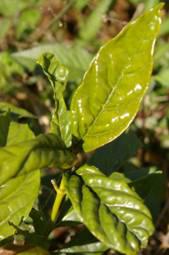
Flower radially symmetrical, bisexual. Calyx tubular, lobes 5, lanceolate, green. Corolla tubular, lobes 5, oblong, 20-30 mm long, 15-20 mm wide, white to yellow, without markings. Stamens 5; filaments free, inserted on perianth, all the same length. Ovary inferior, 2-locular. Style 1. Fruit a hairless, ellipsoid berry (10-)12-25 mm long; rind smooth, thin and soft, orange. Seeds 8-12 mm long, 2-4 mm wide.
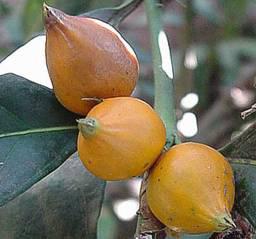
Conservation Status
Status
The dwarf-loquat has the status of `Least Concern' in the Red List of Raimondo et al. (2009). It is widespread, both in nature and in cultivation and not rare where it occurs.
Distribution and habitat
Distribution description
Mitriostigma axillare is typically located in coastal, dune and mist-belt forests ranging from the Eastern Cape to Kwazulu-Natal, or maybe as far as Mozambique. This small tree or understorey shrub, as it has often been described, grows in areas that receive partial (4-6 hours) or light (2-4 hours) direct sun per day, adequate rainfall, and is often found in soils that are rich in nitrogen and low in salt.
Derivation of name and historical aspects
History
The genus name is derived from two Greek words: mitrion, the diminutive form of a word indicating a girdle, turban or bishop's mitre, and stigma, the part of a flower receptive to pollen; in this genus the stigma is thick and split in two. The specific qualifier axillare reminds one that the flower-heads are borne in the axils of leaves rather than at the ends of branches. There are three species in the genus Mitriostigma, one from Kenya, one from Equatorial Guinea and ours, which is restricted to Kwazulu-Natal and Eastern Cape, although Bridson (1979) lists it from Mozambique as well. The genus is most closely related to Oxyanthus, a widespread tropical and subtropical African genus of some dozen species. These two genera both belong to the subfamily Cinchonoideae of the large, mostly tropical family Rubiaceae (coffee family). Possibly the best known member of this subfamily is the South American genus Cinchona, original source of the antimalarial, quinine.
Ecology
Ecology
To date very little research has been conducted on the pollination and methods of seed dispersal of Mitriostigma axillare. Nevertheless, this species produces strongly scented white flowers which are distinctive of moth-pollinated plants. Since moths are generally nocturnal insects and have a good sense of smell, it is highly likely that they are attracted to the sweetly scented white (easier to see at night) flowers of Mitriostigma axillare. In addition, the morphological features of these flowers (i.e. tubular corolla and petals curled backwards) suggest that they are adapted to accommodate moth pollinators.

The fruits of Mitriostigma axillare are fleshy, bright orange (most likely to attract animals) and remain on the tree for many months. The relative size of these fruits (± 25 mm long) as well as the seeds (± 10 mm long) seems to indicate that they may be consumed by birds or monkeys. This would in turn aid in the distribution of seeds.
Since not much is known about the ecology of this species, it would be extremely useful if a talented, enthusiastic scientist could take the time and effort to observe the pollination patterns and the possible agents consuming the fruits.
Uses
Use
Dwarf-loquat has white, star-shaped flowers which bloom between August and November and occasionally throughout the year, thus creating an attractive feature for most gardens. With its sweet, orange-blossom-scented flowers it would be a welcome addition to most homes and a perfect indoor companion. There are no other recorded uses.
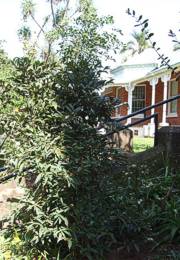
Growing Mitriostigma axillare
Grow
This plant has been a regular feature of the Botanical Society's annual plant sale in Durban for many years, and the easiest way to acquire a small plant is therefore to buy one, either at the plant sale or from a nursery. They grow slowly to extremely slowly in a garden, are highly sensitive to frost and open ground, and therefore make a good understorey in a warm, shady corner. Remember to water regularly.
If, however, you wish to propagate Mitriostigma axillare on your own, the most suitable methods would involve seeds or summer cuttings. Collect as many fruits as you can because the seeds, as well as the fruits, are heavily infected with insect larvae. Sow freshly harvested (vigour and viability deteriorate over a period of time) clean seeds in pots or seedling trays. Once plants appear to be more robust or hardy, transplant them into larger pots. Remember that these seedlings are extremely fragile, so handle with care. Place plants in partial or light shade with an adequate water supply. Apply a liquid fertilizer that contains a rich nitrogen source.
When working with cuttings always use those that have been taken in summer. These cuttings should be approximately 100-150 mm long and ideally should contain a few nodes. Ensure that the cut surfaces are not jagged as this could increase the chance of infection. Remove the leaves and buds from the lower end of the cutting before placing it into a clean pot containing seed compost (preferably bought from a nursery). Additionally, a rooting hormone may be applied to the base of the cutting to stimulate root formation. Place the pot in a warm, shady spot and remember to keep the soil moist. After approximately four weeks (occasionally longer), transplant the cuttings into bigger containers. Bigger pots should be introduced gradually as this could affect further development. These cuttings are extremely fragile, so take care not to damage the delicate root system during this process.
We have seen no particular pests or diseases attacking this plant in cultivation.
References
- Bridson, D. 1979. Studies in Oxyanthus and Mitriostigma (Rubiaceae subfam. Cinchonoideae) for part 2 of `Flora of Tropical East Africa: Rubiaceae'. Kew Bulletin 34: 113-130. Carr, J.D. 1994. The propagation and cultivation of indigenous trees and shrubs on the Highveld. Sandton Nature Conservation Society and the Tree Society of Southern Africa, Johannesburg.
- Coates Palgrave, M. 2002. Keith Coates Palgrave Trees of southern Africa. Struik, Cape Town.
- Garofalo, J., McLaughlin, J. & Yurgalevitch, C. 2000. Groundcovers for shade: South Florida. Miami-Dade County / University of Florida Cooperative Extension Service, Miami, USA.
- Glen, H.F. 2004. SAPPI What's in a name? Jacana, Johannesburg.
- Joffe, P. 2001. Creative gardening with indigenous plants: a South African guide. Briza Publications, Pretoria.
- Nichols, G. 2005. Growing rare plants: a practical handbook on propagating the threatened plants of Southern Africa.Southern African Botanical Diversity Network Report No. 36. SABONET, Pretoria.
- Pooley, E. 1998. A field guide to wild flowers: KwaZulu-Natal and the Eastern region. Natal Flora Publications Trust, Durban.
- Pooley, E. 2006. Forest plants in the forest and in the garden: Popular guides to the biomes of South Africa. Book 1. The Flora Publications Trust, Durban.
- Raimondo, D., Von Staden, L., Foden, W., Victor, J.E., Helme, N.A., Turner, R.C., Kamundi, D.A. & Manyama, P.A. (eds). 2009. Red List of South African plants. Strelitzia 25. South African National Biodiversity Institute, Pretoria.
- Wells, M.J. & Condy, G.S. 1997. Mitriostigma axillare. Flowering Plants of Africa 55: 108-111.
Credits
Hugh Glen & Krivashni Govender
Kwazulu-Natal Herbarium, Durban
May 2010
Plant Attributes:
Plant Type: Shrub, Tree
SA Distribution: Eastern Cape, KwaZulu-Natal
Soil type: Sandy, Loam
Flowering season: Spring, Winter
PH:
Flower colour: White
Aspect: Shade, Morning Sun (Semi Shade), Afternoon Sun (Semi Shade)
Gardening skill: Challenging
Special Features:
Horticultural zones









Rate this article
Article well written and informative
Rate this plant
Is this an interesting plant?
Login to add your Comment
Back to topNot registered yet? Click here to register.